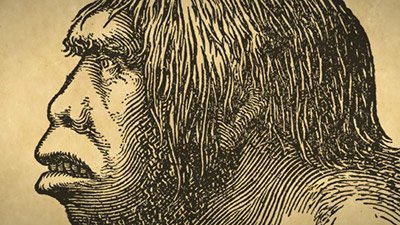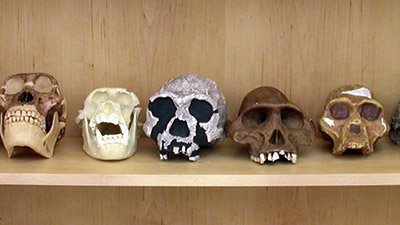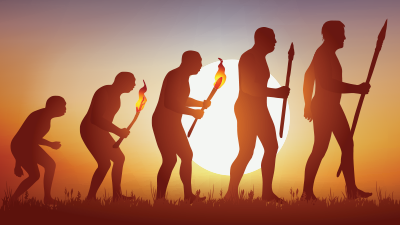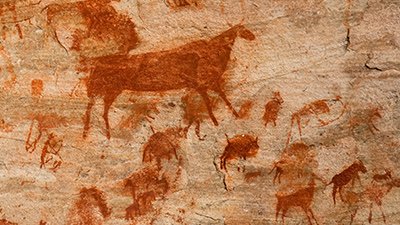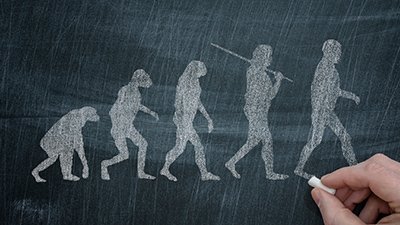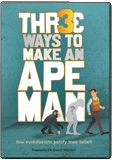Human Evolution
There are only three ways to make an ape-man: 1) make an ape more human-like, 2) make a human more ape-like, or 3) fraudulently mix the two together. Homo naledi, a new fossil species discovered in a South African cave chamber, is another example of trying to make an ape more human-like.
Humans and Chimps Alike?
Determining the genetic basis for differences between humans and chimps does not explain the origin of those differences. We share not a common ancestor but a common Designer.
Who Were Cave Men?
Genetics has clearly established that Neanderthals and Denisovans were fully human. Any physical differences should be viewed as nothing more than variations that can occur within the human race descended from Adam and Eve.
Fossils of Cave Men
Human fossils —and their stone tools—are strikingly similar everywhere they are found in the Lower and Middle Pleistocene layers. These people had large brow ridges, small chins, and receding foreheads.
Evolving Intelligence
Evolutionary anthropologists believe mental abilities had to evolve. Yet they note large gaps in this archaeological record across which it is difficult to discern whether mental evolution was gradual or punctuated by leaps and losses.
Human Evolution Topics
-
Ape-Man
Can man’s ancestry be traced back to an ape-like ancestor? How much do we really have in common with primates? Have fossil ape-men been found?
-
Australopithecus sediba
Australopithecus sediba is not an ancestor of man. The evidence properly interpreted shows that such fossils are either human or ape, not an in-between species.
-
Cavemen
Was early man truly a stone-age, lumbering brute grunting his way toward primitive language? The evidence says the opposite—early man was intelligent!
-
Hominids
The news often eagerly reports the discovery of another link in the supposed chain of hominid evolution. What do these finds really show?
-
Homo floresiensis
The Homo floresiensis of Indonesia, three-foot-tall people affectionately called hobbits, were fully human descendants of Adam and Eve.
-
Human Origins
Humans have always been interested in our origins: where did we come from, and how did we get here? The Bible soundly answers the question of human origins.
-
Lucy
Was the australopithecine Lucy—most famous of all the supposed human ancestors—really a precursor to modern man, or was she simply an ape?
-
Neanderthal
Neanderthals are often treated as subhuman despite having all the hallmarks of full humanity. Except a few skeletal variances, they were very similar to us.
-
Piltdown Man and Other Frauds
Piltdown man, and other paleoanthropological hoaxes and forgeries, call attention to the academic dishonesty that is sometimes pedaled as evolutionary evidence.
-
What Makes Us Human?
Evolutionists say that man is just an animal, descended from an ape-like ancestor. However, humans show features that clearly separate us from animals.
News About Human Evolution
-
April 4, 2024 from Ken Ham Blog
A recent news article postulated where humans first went after leaving Africa (supposedly) 60,000 to 70,000 years ago.
Articles About Human Evolution
-
Oct. 27, 2024 from Answers Magazine
If you just connect all the dots, isn’t it easy to see how the first humans could evolve from a shared ancestor with the apes?
-
Oct. 16, 2024 from Answers in Depth
Can technology save us?
-
Aug. 18, 2024 from Answers Magazine
Evolutionists claim that this similarity between humans and primates is evidence of common ancestry. Closer study verifies differences that point to a common Designer.
-
Jan. 1, 2024 from Answers Magazine
Archaeologists regularly uncover evidence of early man’s brilliance, confirming that cavemen were smart enough to build fires, design intricate structures, and cook complex cuisine.
-
Jan. 11, 2023 from Answers in Depth
Examining biotechnology—from medical therapies to radical modifications
-
Jan. 1, 2023 from Answers Magazine
No matter how hard they try, scientists can’t connect the missing links in human evolution. Why not?
-
Nov. 25, 2022 from Answers in Depth
BCIs could help reverse devastating medical conditions but could also change what it means to be human.
-
Feb. 6, 2022 from Answers Magazine
The discovery of an ancient man entombed in the Alps’ ice was one of the greatest finds of the last century.
-
Dec. 7, 2019 from The New Answers Book 4
Our modern society believes we are just reaching the height of human intelligence. If we accept this evolutionary view, what do we do with the biblical account?
-
Nov. 16, 2019 from The New Answers Book 4
Perhaps, in fact, it’s our discomfort with not knowing what to do with cavemen that makes us laugh. So just who were they?
-
Oct. 6, 2017 from Answers in Depth
Scientists report the biochemical footprint of a particular sugar polymer—a type that modern humans cannot make—has been found in an ancient African fossil.
-
July 30, 2017 from Answers in Depth
Amphioxus is an “obvious” link between invertebrates and vertebrates for those who believe they must be linked by a shared evolutionary ancestor.
-
July 15, 2017 from Essays on Origins: Creation vs. Evolution
Evolutionists insist that the underlying similarity of all animals, including man, is compelling evidence for their evolution from a common ancestor.
-
April 6, 2017 from Answers in Depth
Are human feet the foundational distinction between knuckle-walking apes and us? How did we learn to walk this way?
-
Dec. 16, 2016 from Answers in Depth
A study in Proceedings of the National Academy of Sciences suggests that the modern practice of Caesarean section is rapidly altering human evolution.
Recommended Resources

Answers in Genesis is an apologetics ministry, dedicated to helping Christians defend their faith and proclaim the good news of Jesus Christ.
- Customer Service 800.778.3390
- © 2024 Answers in Genesis


